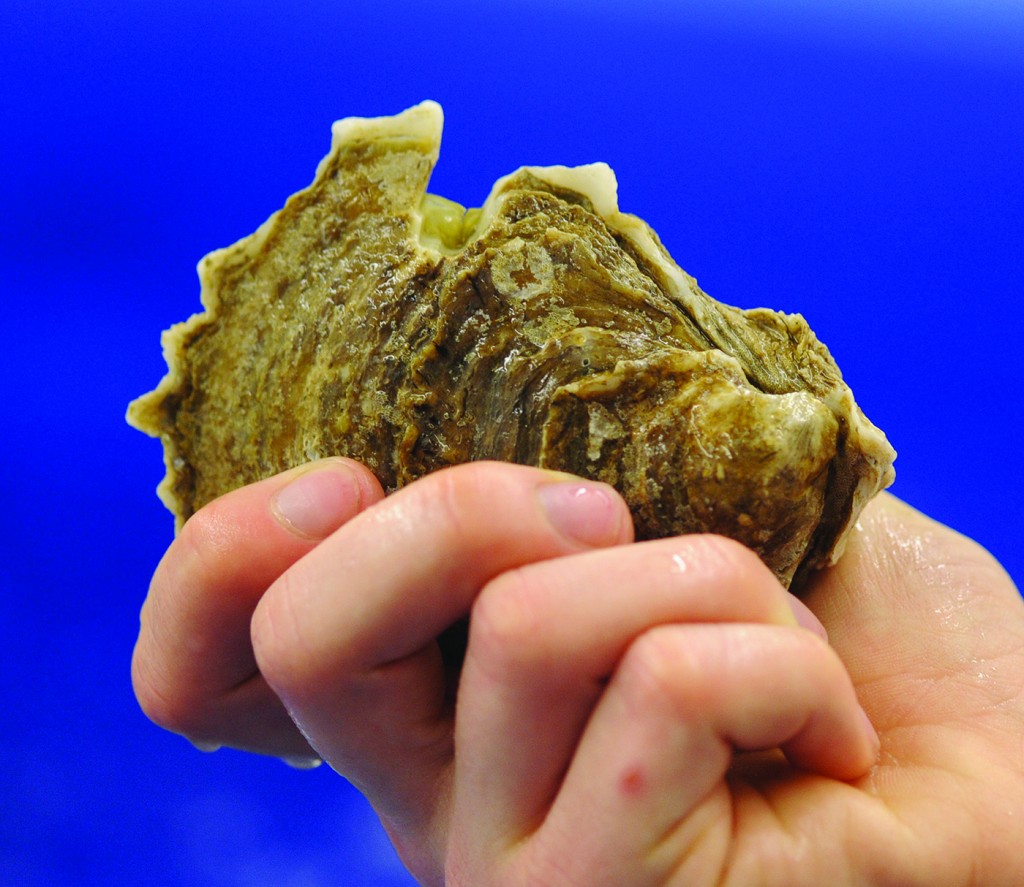Oyster Medics

Falwell notches the shell and watches the oyster repair the wound. Photo by Patrick Wright.
Old-style oystermen have always known about it but, as is their nature, don’t make a fuss over it, or for that matter, over much of anything else an oyster does. Just part of the nature of a quiet little beast that appears to grow from nothing anyway.
Tongers—the people who use long-handled, steel-jawed rakes called tongs—know they can damage oyster reefs during periods of intense harvest. But they also know the silent beds of bivalves below them have a way of healing themselves if given enough time. As it turns out, how oysters do that is one of the great marvels in marine science.
Beth Falwell, a doctoral candidate in Andrew Mount’s Okeanos lab, is a specialist in studying how oysters heal wounds to their shells. Her experiments on Gulf oysters are a key part of research that is changing scientific understanding of the curious phenomenon of shell formation in all marine animals, not just in oysters.
Falwell starts by using a grinder to cut a small notch in the lip of an oyster’s tightly clenched shell. She makes the notch just deep enough to breech the occupant’s internal cavity but not enough to seriously injure the animal. Then she watches carefully and records what happens, which, if written into a Hollywood movie script, might get a rise out of Steven Spielberg.
A nearly invisible army of gelatinous, amoeba-like cells soon emerges from the oyster’s mantle (skin) and starts crawling toward the wound. Within a few hours, a fresh cut will be covered with these cells that stretch and pull themselves along in a manner straight out of Transformers.
Brick by brick
Every time she runs such an experiment, Falwell is witnessing how oysters have been building and repairing their rock-hard houses for hundreds of millions of years. Joining Mount’s team in 2008, Falwell is at the forefront of research aimed at figuring out exactly how oysters—devoid of brains, nervous systems, and even circulating blood—manage to pull off this amazing feat.
In 2004, Mount’s lab published in the journal Science an article documenting the discovery of a highly specialized oyster cell (the organism has several, and all are white) that contains an organ capable of manufacturing the basic building blocks for shell construction, nano-sized crystals of calcite, the most common form of calcium carbonate. The organ, called an exosome, contains a package of proteins fully capable of building these calcite “bricks” on demand. The research then revealed an even neater trick. To get the “bricks” to wherever they’re needed, the special, exosome-carrying cells (called hemocytes) simply crawl out of the oyster’s fleshy mantle and head for the “job site.”
But how in the world do they know where to go? With no nerve endings (no nerves, period) to point the direction to an injury, how is it possible that this army of oyster medics can unerringly find it in short order?
“We know that some kind of signaling occurs, but what it is we don’t fully understand yet,” Falwell says, holding up a freshly notched oyster. “The healing response may be triggered mechanically by the vibration [of the grinding] or by some chemical pathway or maybe both.”
The most intriguing clue she’s come up with so far involves a powerful family of enzymes known to be involved in wound healing in a wide variety of organisms, including plants, but particularly in humans and other mammals. First isolated by biochemists working in 1962, the special enzymes are called matrix metalloproteinases, or MMPs. The key roles these compounds play in rebuilding damaged tissue have since been established and are thus considered part of an organism’s disease-fighting immune system.
Picking up on research done by a former team member who isolated a promising MMP candidate involved in shell repair in 2009, Falwell has since found the compound in oyster hemocytes. When she implanted glass cover slips into oyster notches, she soon found MMP-loaded hemocytes aggregating by the thousands on the slips. Within twenty-four hours, the slip implant revealed a prominent growth of newly deposited calcite crystals. It was all she needed to conclude that MMPs play a powerful role in hemocytes’ abilities to repair damaged shells.
Since then, she’s found other evidence that suggests that oysters may use proteins in their mantle tissue to regulate MMPs, or to turn them on and off. Could this be a clue about how the organism knows when to order up a repair detail and where to send it? The answer lies in more research, Falwell believes.
Given the nature of molecular biology—organisms typically have a variety of ways to solve problems—chances are good that oysters have other means at their disposal to heal themselves, she says.
“I’m sure there are many pathways at work here, a built-in redundancy. But knowing at least one thing that’s going on in shell repair would be cool,” Mount says.


